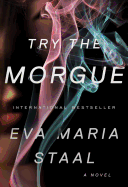Recently, following the ceremony for the Boston Globe-Horn Book Awards, Roger Sutton, editor-in-chief of the Horn Book and Cathryn Mercier, director of the Center for the Study of Children's Literature at Simmons College in Boston, presented a remarkable day-long colloquium on children's literature.
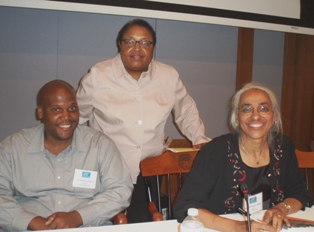 |
|
R. Gregory Christie, Deborah Taylor and Vaunda Micheaux Nelson, at a panel on No Crystal Stair.
|
We learned how nonfiction winner Chuck Close: Face Book by Chuck Close (Abrams) began with the three-part flip book at the volume's center, and how 12 fifth-graders from P.S. 8 in Brooklyn asked the central questions that formed the text. An image of a girl and her dog wrapped in colorful yarn on Jon Klassen's website sparked Mac Barnett's story for Extra Yarn (Balzer + Bray/HarperCollins). And a question repeatedly asked of Vaunda Micheaux Nelson--"Micheaux... Are you related to that bookseller in Harlem?"--prompted what she calls a "documentary novel," No Crystal Stair (Carolrhoda Lab/Lerner), illustrated by R. Gregroy Christie. It's about Nelson's great-uncle Lewis Micheaux, a self-educated man who opened the National Memorial African Bookstore, which became a cultural gathering place for the African-American community, frequented by Malcolm X and other leading thinkers.
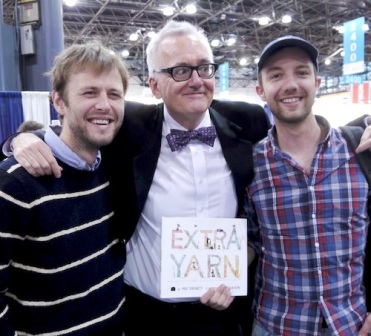 |
| (l.-r.) Mac Barnett, Roger Sutton and Jon Klassen at BEA. (photo courtesy of the Horn Book) |
The books' creators, along with librarians and teachers, took attendees deeper into the books and the issues facing those who work with children's literature. Barnett and Klassen spoke of leaving room for readers to bring their own experiences to Extra Yarn. They cited the spread of the ladders of the three robbers, the intruders' footpaths to the departure site of their boat, and the "aha" moment indicated by the light on in Annabelle's room suggesting she's discovered that her yarn is gone. Klassen leaves evidence that the theft occurred, but without an overt threat of danger.
Barnett, a chief architect of the "Proclamation!" in defense of picture books (a reaction to Julie Bosman's article in the New York Times about the demise of the picture book) led a panel discussion about how he recruited fellow picture book creators for the cause. In a breakout session later that day, led by Enoch Pratt Library's Deborah Taylor, however, teachers and librarians expressed concern that parents are rushing their young children out of picture books and into beginning readers--and even into chapter books. Part of librarians' and educators' job, they believe, is to educate parents about the depth of experience picture books offer, and the importance of allowing children to linger there.
Participants also got to discuss in greater depth all of the Boston Globe-Honor Book Award winners and honorees and how they relate to the Common Core. Books such as No Crystal Stair, as illustrator Christie said, offer a more "balanced curriculum," with individuals omitted from history textbooks. Teachers and librarians expressed concern that, with pressure to teach to the test and an absence of librarians in many schools, teachers won't have the resources necessary to cull the best of children's books to teach to the Common Core standards. The challenge will be to find ways of keeping teachers current and getting good new books to students, and to not rely solely on the titles provided in the appendices. Another disturbing trend discussed was the proliferation of young adult books not intended for teens, but rather for the increasing number of adults who buy YA books for themselves, and how the genre is skewing older.
 |
|
Erin E. Stead, Julie Fogliano and Neal Porter (And Then It's Spring)
|
The colloquium's theme, "Look Out!", permeated the conversation. The more obvious application surfaced in the viewpoints of the books' characters and subjects--the way Chuck Close sees the world, and allows others to see him through his self-portraits; the way Lewis Micheaux invited visitors to his bookstore to look at themselves differently from how white society viewed African-Americans, their history and their culture; and the way Elizabeth Wein's honor book Code Name Verity (Hyperion/Disney), and Mal Peet's honor book Life: An Exploded Diagram (Candlewick) invited young adults to look at war and its influences through the eyes of individuals who experienced it.
More surprising twists included Megan Lambert, a judge for the awards, admitting that she viewed the artwork of Gary Kelley for And the Soldiers Sang differently because of parallels fellow judge Thom Barthelmes saw between Kelley's illustrations and the work of Egon Schiele, an artist painting at the time of the book's subject, the "Silent Night truce" during the Great War. And Lambert discussed the connections her daughter made between Jon Klassen's bear and rabbit in Extra Yarn and in I Want My Hat Back ("He must have done Extra Yarn first," her daughter observed, "because... the rabbit dies in I Want My Hat Back") and how her daughter also saw the boy in And Then It's Spring as a young Amos McGee, not knowing that Erin E. Stead had illustrated both books.
And because so many in attendance share the spirit of Lewis Micheaux, they took "Look Out!" as marching orders of a sort: look out for good books; look out for their readers. Teach parents to linger longer over picture books; point teens to the true YA books meant for them. Look for the books that will explode the curriculum into stories that take them into deeper, more complex places and conversations. --Jennifer M. Brown
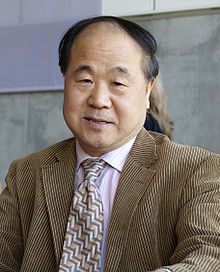 The 2012 Nobel Prize in Literature has been awarded to Chinese author Mo Yan, "who with hallucinatory realism merges folk tales, history and the contemporary," according to the citation read by Peter Englund, permanent secretary of the Swedish Academy.
The 2012 Nobel Prize in Literature has been awarded to Chinese author Mo Yan, "who with hallucinatory realism merges folk tales, history and the contemporary," according to the citation read by Peter Englund, permanent secretary of the Swedish Academy. 







 Tripp Ryder, general trade manager at Carleton College Bookstore in Northfield, Minn., has been appointed president of the
Tripp Ryder, general trade manager at Carleton College Bookstore in Northfield, Minn., has been appointed president of the BINC.0902.T2.CARLAGRAYSCHOLARSHIP.jpg)
 Kobo has made partnerships with
Kobo has made partnerships with 
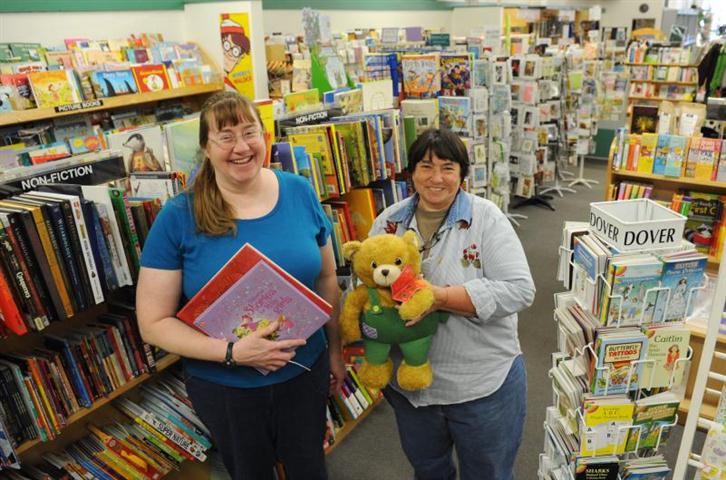
 Calling it the "end of an era," owner Victoria Moreno announced on her website that the
Calling it the "end of an era," owner Victoria Moreno announced on her website that the 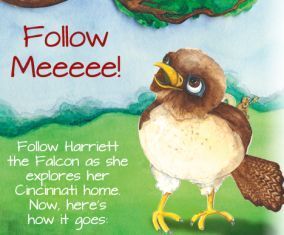 Readers of the book can go to Orange Frazer Press's website and click "
Readers of the book can go to Orange Frazer Press's website and click "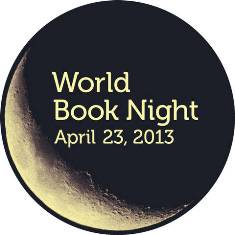 World Book Night U.S. has announced the following appointments:
World Book Night U.S. has announced the following appointments: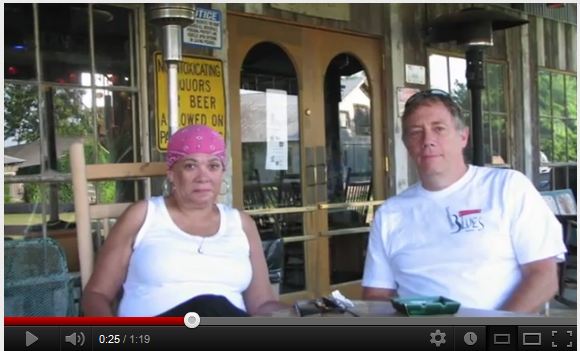 Gather at the Table: The Healing Journey of a Daughter of Slavery and a Son of the Slave Trade
Gather at the Table: The Healing Journey of a Daughter of Slavery and a Son of the Slave Trade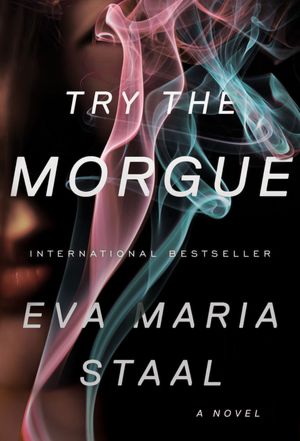 The pseudonymous Eva Maria Staal's first novel, Try the Morgue, deftly marries an edgy thriller to a sensitive literary story. It's narrated by Maria, a complex young woman caught between her desire for a stable family and the emotional rush she gets from lucrative, often illegal gun deals. Maria goes to work for Jimmy Liu, a Chinese Canadian with a taste for expensive glamour boys and a knack for making money. He teaches her all about clandestine weapon shipments, backroom brokering, bickering among dealers and slipping across borders under fake papers. Jimmy's personal attention attracts her as much a rich deal does. "He sees things in me that I don't see," she explains, "that no one sees."
The pseudonymous Eva Maria Staal's first novel, Try the Morgue, deftly marries an edgy thriller to a sensitive literary story. It's narrated by Maria, a complex young woman caught between her desire for a stable family and the emotional rush she gets from lucrative, often illegal gun deals. Maria goes to work for Jimmy Liu, a Chinese Canadian with a taste for expensive glamour boys and a knack for making money. He teaches her all about clandestine weapon shipments, backroom brokering, bickering among dealers and slipping across borders under fake papers. Jimmy's personal attention attracts her as much a rich deal does. "He sees things in me that I don't see," she explains, "that no one sees."